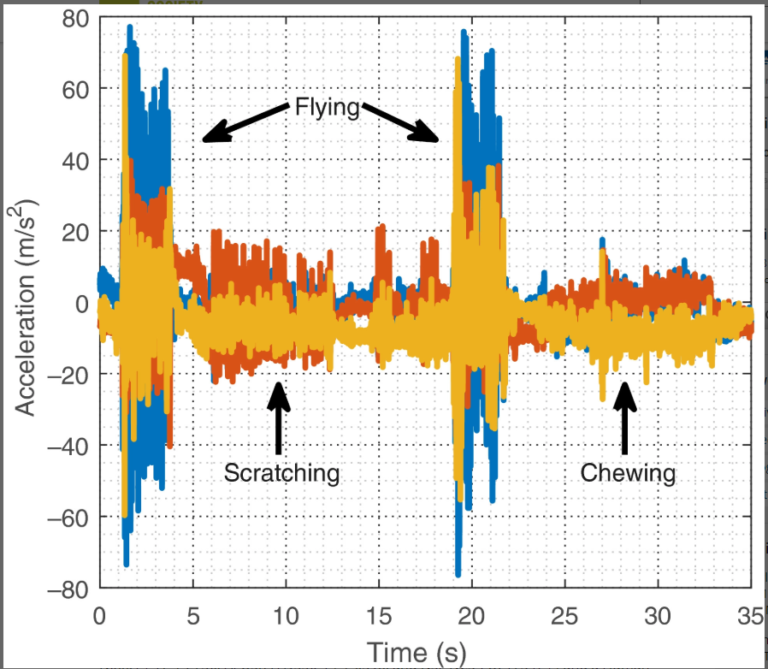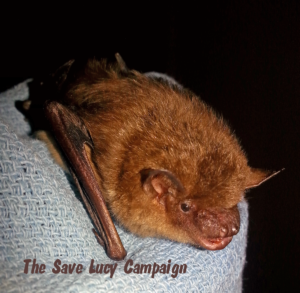
Hi everyone! I hope you all had a good week! I have some exciting batty news! Scientists have figured out a way to study the echolocation of bats. By studying bat echolocation, they are learning about how bats hunt for…

Hi everyone! I hope you all had a good week. Save Lucy’s President, Mrs. Sturges, found an interesting article that looks into the mystery of bat sounds. Scientists have found that some of the sounds that bats make resemble those of birds. Out of the 1,300 different bat species, the social vocalizations of about 50 have been studied. Of those 50, scientists discovered that about 20 of them are actually singing. It’s hard to hear bats singing if you go outside and watch them flying around. This is because a bat’s vocal range is in the ultrasonic range that is inaudible to human ears. In order to hear the bats’ sounds and research them further, scientists recorded bats singing and slowed them down. Their research has shown some similarities between bat and bird songs. Both bats and birds use the basal ganglia and prefrontal cortex parts of their brains to sing. Scientists believe that neural circuits also control bat vocals and how they are able to sing. Even though most bat species sing in an ultrasonic range, one species loves to sing in a range that humans can hear. The singing of the Greater Sac-Winged bat can be heard for miles. If you would like to read more about bats singing, you can find the article here. And now for a public service announcement. Daylight Savings Time begins on Sunday. Don’t forget to move your clocks 1 hour ahead before you go to bed tonight.
Hi everyone! I hope you all had a good week. I would like to dedicate this week’s blog to the people affected by the fires in Northern California. I hope that weather brings you some rain soon and the fires can be brought under control. My thoughts are with you all. I am studying poetry in my English class. One of my assignments was to research a famous poet and then to write an original poem using that poet’s style. I researched William Blake, so I decided to try and copy the style he used in his poem “The Tyger”. I wrote about the misunderstood and underappreciated bat that people often call “ugly”. It was difficult to write because, well, bats are adorable! I needed inspiration and as you all know, little bats are very poetic. So, with their inspiration, but definitely not their talent, I managed to write a poem that I would like to share with you all now. I hope you like it. The Bat Big Brown Bat flying light In the skies of the night You’re called ugly by those who see What is outside, not within thee Catching bugs only you can hear How do you see them from so far, not near? With echolocation – a spectacular sense From which a bug has little defense Big Brown Bat in the night Aiding farmers in your flight A life of service. Don’t you see? Helping humans just like me But your appearance causes prejudice Sadly, they don’t see your selflessness Instead they see a hideous troll Missing that deep in your eyes is a loving soul Your purpose in life is actually simple To stray from it would be quite sinful Please save us from the plight Of the unfortunate mosquito bite Big Brown Bat […]
Baturday News is a weekly blog written by Rachael, a high school student, bat advocate, and Save Lucy volunteer. Rachael’s interest in bats was sparked by the big brown bats that used the outside of her former home for a winter roost. She now enjoys watching the bats fly over her home on summer evenings. Rachael has been writing the Baturday News for over three years. Hi everyone I hope you all had a good week! I found a really cool article about how scientists are studying bat echolocation to help with all kinds of things. The US. Navy is making a new sonar for their ships. The new sonar is going to be based off of how bats echolocate. The Navy ships already have sonar, but it isn’t anything like a bat’s. Even though a bat only uses its two ears and a Navy ship uses complicated sonar arrays, bats still have a better idea of what things are. Using information learned by studying bats, an engineer built a prototype that goes on the nose of an undersea robot. The new device can interpret returning sonar echoes like a bat’s ears. It will also be cheaper, and smaller than their current model. Much like the US Navy, researchers in Israel are also information learned by studying bat echolocation. But instead of using the information to help the military, they are using it to help farmers. Farmers sometimes have trouble knowing how much food they are actually going to get from the plants in their field. Some years, crops might yield more food than others and it is difficult for a farmer to estimate how much they will have from year to year. This makes it difficult for them to determine a good price for that year’s crops and how […]
Baturday News is a weekly blog written by Rachael, a high school student, bat advocate, and Save Lucy volunteer. Rachael’s interest in bats was sparked by the big brown bats that used the outside of her former home for a winter roost. She now enjoys watching the bats fly over her home on summer evenings. Rachael has been writing the Baturday News for over three years. Hi everyone! I hope you all had a good week. It has been another difficult week for a lot of people. Not only did Hurricane Irma move through the Caribbean and Florida destroying everything in its path, but wildfires are burning in the western United States. My thoughts are with everyone affected by these disasters. While the US has been dealing with hurricanes and fires, the country of Mexico has been dealing with its own disasters. Last week, an 8.1 magnitude earthquake hit Mexico. This was the worst earthquake to hit Mexico in a century. Just hours after the earthquake, Hurricane Katia hit Mexico’s Atlantic coast. A few days later, Hurricane Max hit Mexico’s Pacific coast. I would like to dedicate this week’s blog to the people of Mexico. These disasters affected the entire country and my thoughts are with you all. Mexico has a total of 137 species of bats. One of these species is the Mexican Fish-eating Bat. The Fish-eating bat is an adorable bat that lives near the Gulf of California in Mexico. Instead of bugs, this bat loves eating fish and crustaceans. They have strong legs and big feet for carrying their food. They use their sharp claws to capture their prey. Fish-eating bats have brown fur that is dark gray at the base. They mostly roost in caves and crevices, but will also stay in rock slides. If […]
Baturday News is a weekly blog written by Rachael, a 7th grade student and Save Lucy volunteer. Rachael’s interest in bats was sparked by the big brown bats that used the outside of her former home for a winter roost. Her family cheerfully hosted this wild colony for years. Hi everyone! I hope you all had a good week. I found some news that I think is really cool. Apparently, bats are even more useful than I thought. Some students at Wake Forest University in North Carolina are using bats as a model for a device they are making. They think the device will be able to help blind people. The device sort of looks like a watch and uses echo location to determine where things are and how close stuff is. If a person gets close to an obstacle, the wristband vibrates. The closer the person gets, the faster the watch vibrates. It only costs $35 per watch. I really hope it works. I have a visually impaired friend who I think would love this. You can read the article here.


